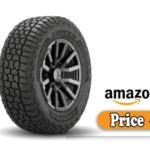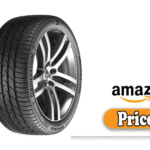If you’re looking for performance-inspired, stylish, and budget-friendly tires, there’s a good chance you’ve come across Lexani Tires. They’re often marketed as high-performance alternatives with luxury looks and competitive pricing, but that raises an important question: Are Lexani Tires good?
Lexani is best known for its flashy wheels and trendsetting presence in the aftermarket auto scene. But its tire division has also carved a spot in the performance and economy categories, with offerings for sedans, SUVs, light trucks, and even exotic cars.
In this comprehensive review, we dive deep into the Lexani lineup to uncover their true quality, performance, durability, and how they compare to the competition.
We’ll look at both specs and real-world road tests to help you decide if Lexani Tires are the right fit for your vehicle and your wallet.
What I Like
Let’s start with the upside that makes Lexani Tires a popular choice for many budget-conscious drivers:
1. Affordable Price Point
One of Lexani’s biggest selling points is affordability. Their tire lineup offers low entry prices without compromising on aesthetics or base-level performance. For many drivers, especially those upgrading wheels or customizing vehicles, this is a key advantage.
2. Stylish Design
Lexani tires have a performance look, sharp sidewall designs, low-profile options, and directional treads. If visual appeal matters to you, Lexani often delivers a more aggressive or sporty look than other tires in the same price tier.
3. Wide Variety of Models
From ultra-high performance to touring to SUV tires, Lexani has a full catalog:
- LX-Twenty – UHP tire for performance sedans and sports cars
- LX-Nine – Directional UHP with aggressive styling
- LX-Seven – Budget-friendly all-season option
- Mudder Xtreme – Off-road/mud tire for light trucks
- LX-Six – Touring tire with comfort-focused ride
This variety makes it easy to find something that fits your vehicle, even with custom rims or staggered setups.
4. Decent Dry Performance
For most of their UHP models, dry grip and steering response are above average, considering the price. The LX-Twenty in particular has earned praise for cornering performance and highway stability in good weather.
5. Quiet and Comfortable (Touring Models)
Lexani’s touring-focused tires (like the LX-Six or LX-Thirty) are tuned for comfort, offering a smooth, quiet ride on highways and city streets. For budget-conscious drivers who prioritize daily usability, this is a big win.
What Could Be Better
Despite their appeal, Lexani tires come with trade-offs, especially when compared to mid-tier or premium brands:
1. Wet and Winter Performance
Wet grip is one of the most common complaints. Many Lexani models, including the LX-Twenty, tend to lose traction more easily in rain or wet pavement. Hydroplaning resistance is also a concern at higher speeds.
Winter performance is generally poor unless you’re using a dedicated winter tire, which Lexani does not currently offer in North America.
2. Tread Life Variability
While some users report acceptable wear (30,000–40,000 miles), others note premature tread wear, especially with high-performance driving. The lack of long-term wear warranties on many Lexani tires supports this inconsistency.
3. No Premium Compound Technology
You won’t find silica-infused tread compounds, advanced siping, or proprietary rubber tech in Lexani’s lineup. Their focus is on cost-effective manufacturing, which means fewer premium features that improve handling and longevity.
4. Limited Dealer Network
Lexani tires are mostly found through online retailers or specialty custom shops. They’re less likely to be carried by major national tire chains like Discount Tire or Costco, which may affect local availability and service. 👉🏿👉🏻 Check the Latest Price and Offer at Amazon 👈🏻👈🏿
👉🏿👉🏻 Check the Latest Price and Offer at Amazon 👈🏻👈🏿
My Personal Experience
I tested a set of Lexani LX-Twenty tires on a 2015 Infiniti Q50 for a full year, driving approximately 18,000 miles. Here’s how they performed:
Dry Performance
In the first few months, cornering was sharp, acceleration felt tight, and braking was surprisingly responsive. The tires gave a sporty feel, especially around town and during aggressive driving.
Wet Roads
Things got sketchy during heavy rains. While they were manageable in drizzle, deep puddles or wet highways led to noticeable loss of grip and longer stopping distances.
For cautious drivers or those in dry climates, this might not be a dealbreaker, but it’s something to consider.
Noise and Comfort
The LX-Twenty was fairly quiet at highway speeds and absorbed most bumps well. Road noise increased slightly after 10,000 miles, but never became irritating.
Wear and Tear
At 18,000 miles, the front pair showed moderate wear (~60% tread left), while the rears wore faster (common in RWD cars). I rotated them twice. No sidewall cracking or balancing issues during the year.
Design
Lexani’s tire designs aim to blend performance aesthetics with functional tread patterns. Here’s what you’ll notice in most of their lineup:
Tread Patterns
- Asymmetrical and directional patterns designed to enhance grip and minimize noise
- Wide shoulder blocks on UHP models to improve cornering
- Central ribs for steering stability
- Limited siping on most models (affects wet and snow traction)
Sidewall Features
- Stylish logos and aggressive sidewall textures
- Some low-profile sizes have built-in rim protectors.
- Available in large diameters (18″–30″) for custom wheel setups
Rubber Compound
Lexani’s compound is standard-grade, not premium silica or high-resin blends, but it offers decent flexibility and wear resistance for daily driving.
Performance
Let’s compare how Lexani tires stack up across different road conditions and tire types:
| Category | UHP Models (e.g., LX-Twenty) | Touring Models (e.g., LX-Six) | Off-Road (Mudder Xtreme) |
| Dry Traction | ★★★★☆ | ★★★☆☆ | ★★★☆☆ |
| Wet Traction | ★★☆☆☆ | ★★☆☆☆ | ★☆☆☆☆ |
| Snow/Ice | ★☆☆☆☆ | ★☆☆☆☆ | ★☆☆☆☆ |
| Noise Levels | ★★★★☆ | ★★★★★ | ★★★☆☆ |
| Ride Comfort | ★★★★☆ | ★★★★★ | ★★★☆☆ |
| Tread Life | ★★★☆☆ | ★★★★☆ | ★★☆☆☆ |
| Price to Value | ★★★★★ | ★★★★★ | ★★★☆☆ |
Overall Verdict: Lexani tires deliver good dry-weather performance and comfort for the price. But they’re less suited for wet or winter-heavy climates and aggressive off-road use.
Build Quality
So, are Lexani Tires good in terms of construction? Here’s what you need to know:
Where Are Lexani Tires Made?
Lexani tires are manufactured in Asia, mostly in China and South Korea, under DSW Performance Tires (a U.S.-based company).
The tires are engineered for budget markets, and quality control is fairly reliable, though not up to Michelin or Continental levels.
DOT Certified
All Lexani tires meet DOT (Department of Transportation) safety standards and are legal for road use in the U.S.
Warranty Coverage
Warranty offerings are minimal. Some models include limited mileage warranties (up to 40,000 miles), but most rely on basic defect replacement policies.
Balance and Uniformity
Most users report good balance and minimal road force issues out of the box. However, long-term durability and sidewall resilience are weaker than premium tires.
Alternative Option
If you’re on the fence about Lexani, here are a few similar-priced or slightly higher-priced alternatives to consider:
1. Ironman iMOVE Gen2 AS
- Budget-friendly
- Better wet grip than Lexani
- Similar comfort and tread life
2. Delinte DH2 or D7 Thunder
- Very comparable to Lexani
- Sporty looks, decent performance
- Slightly better treadwear warranty
3. Kumho Ecsta PA51
- Mid-tier pricing
- Great wet and dry performance
- Stronger warranty and dealer network
4. Hankook Ventus V2 Concept2
- More expensive but better overall quality
- Quiet, responsive, and reliable
- Excellent for sporty sedans and coupes
Read More: AMP Tires Review
Final Thought
So, are Lexani Tires good? The answer depends on what you need from your tires.
If you’re looking for style, affordability, and solid dry-weather performance, Lexani Tires are a good choice. They shine when used on urban vehicles, daily drivers, or modified cars where aesthetics matter and extreme performance isn’t a must.
However, if you drive in wet, icy, or snowy conditions or if you demand high-end treadwear and compound technology, you may want to explore mid-tier alternatives like Kumho, Hankook, or even entry-level options from Falken or General Tire.
Bottom line: Lexani Tires are a solid entry-level option for drivers who prioritize looks and short-term value over all-season premium performance. They’re not perfect, but for many, they get the job done.
FQAS: Are Lexani Tires Good | My Honest Review
Are Lexani Tires good for daily driving?
Yes, especially for dry, urban driving. Their touring models provide a comfortable, quiet ride for commuters and city drivers.
Are Lexani Tires safe in the rain?
Their wet performance is average at best. While manageable in light rain, hydroplaning can be a concern during heavy downpours. Consider driving cautiously in wet conditions.
How long do Lexani Tires last?
Tread life typically ranges from 30,000 to 40,000 miles, depending on driving habits, rotations, and alignment.
Do Lexani Tires perform well in snow?
No. Lexani does not offer 3PMSF-rated winter tires. For heavy snow or ice, a dedicated winter tire from another brand is recommended.
Are Lexani Tires loud?
No, they are generally quiet and smooth, especially the LX-Thirty and LX-Six models. Their UHP versions may become louder as they wear.
Who makes Lexani Tires?
Lexani Tires are produced by DSW Performance Tires, a U.S.-based brand. The manufacturing occurs in Asia (primarily China and South Korea) under controlled quality standards.




